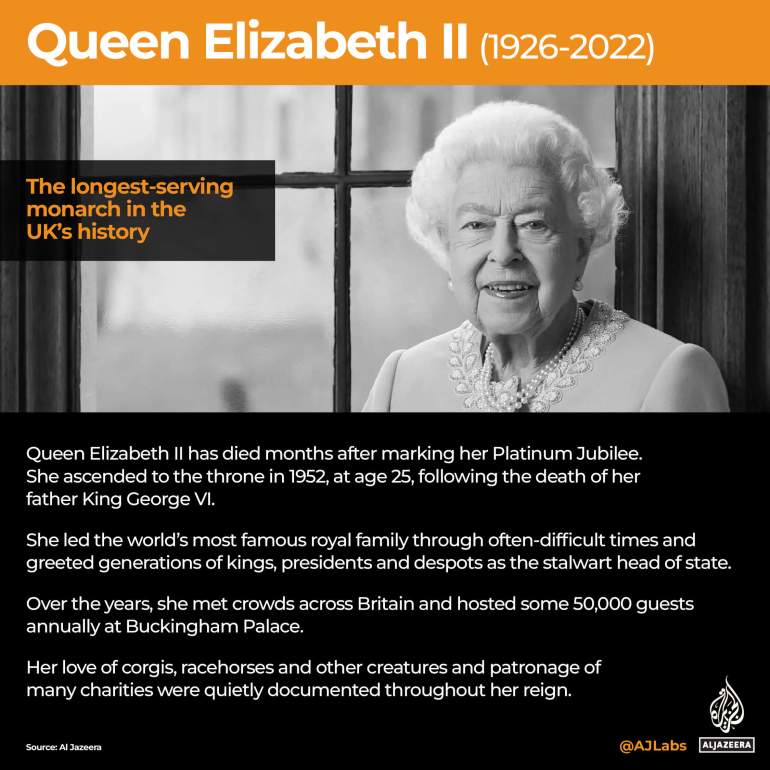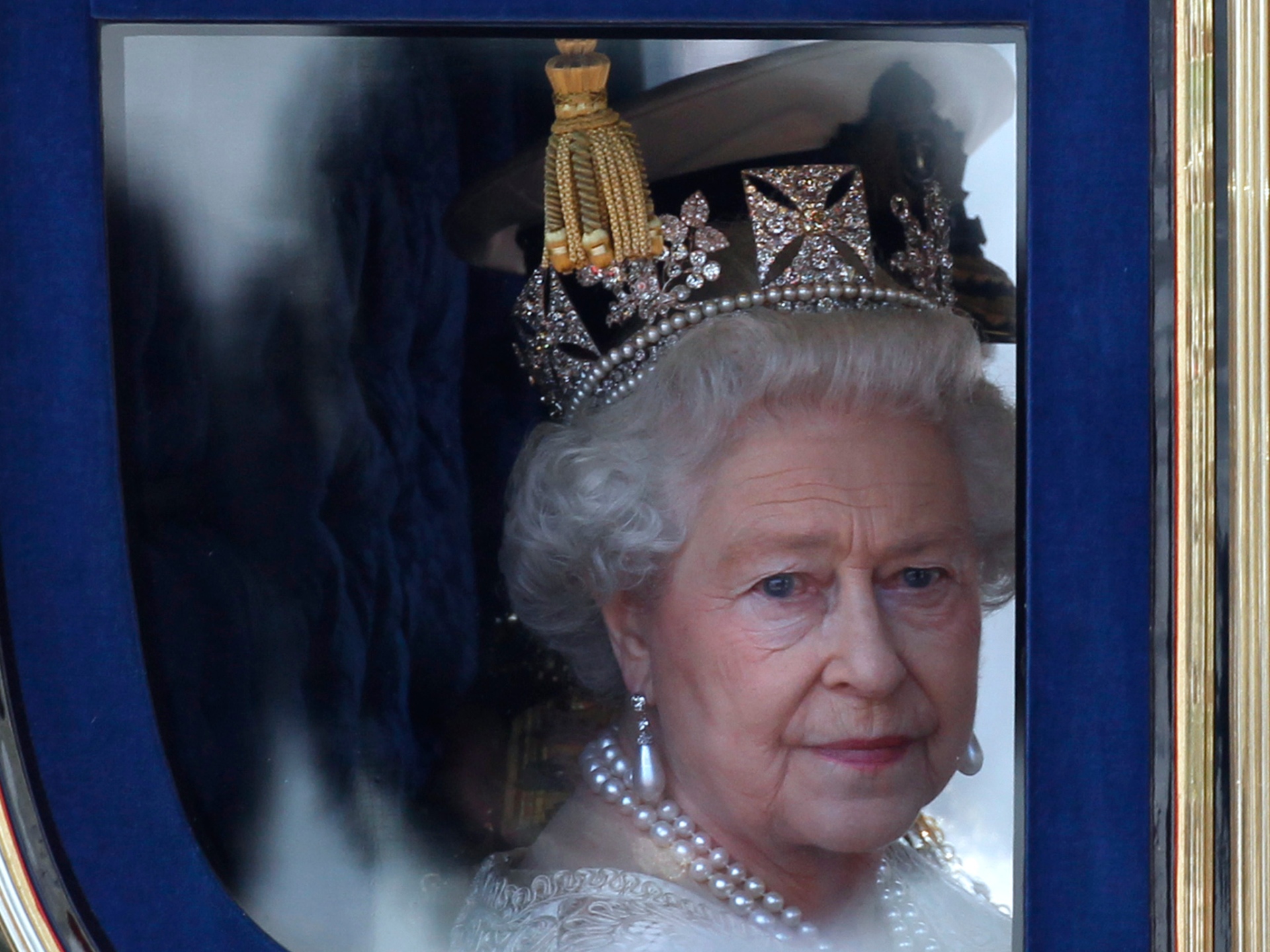In her first public speech, a 14-year-old Princess Elizabeth sent a message of “cheerfulness and courage” to children who had been evacuated from their family homes in a live radio broadcast in the early phase of World War II.
Though it was hardly known in 1940, her distinct shrill voice went on to become instantly recognisable to almost everybody living in Britain and millions more overseas during the reign of Queen Elizabeth II, which ended with her death on Thursday, aged 96.
She led the world’s most famous royal family through often-difficult times and greeted generations of kings, presidents and despots as the stalwart head of state to a key, but declining, nation in seven decades of a global transformation.
“She always put duty first, long after others of her generation had retired. When she became queen, people anticipated a new Elizabethan age of peace and prosperity. Such optimism was justified, with decades of great change and mostly rising living standards,” Elizabeth Norton, a historian, told Al Jazeera.
“During her long life, she weathered many storms. Elizabeth II mostly stood apart from controversy in the royal family – particularly in her later years – and will justly be remembered as one of the best-loved monarchs of the modern period.”
She was born in London in 1926 and was most likely set to remain a princess until she was nudged towards succession by the abdication of her uncle, King Edward VIII, in 1936, and her father – King George VI – was crowned.

She became queen at 25, after her 56-year-old father’s death in 1952, and began a reign that was characterised by change and moral questioning that probed everything up to the privilege that gave her riches, fine jewellery and palaces.
“Her stoic public persona and unchanging personal style offered Britons an unwaveringly consistent figurehead during unparalleled technological and cultural change,” Eloise Parker, a contributing editor at HelloMagazine.com, told Al Jazeera.
“And yet, she quietly kept pace with the times, becoming the last British monarch to communicate by telegram and the first to send a tweet.”
Times were changing. Early in her reign, an annual bash for posh debutantes was moved out of Buckingham Palace and its exclusive summer garden parties were opened up to nurses, builders and others from the bottom of Britain’s rigid class structure.
In 1949, she spoke about the “darkest evils” of divorce and separation. By the 1990s, she was watching her children’s marriages fall apart, including the headline-making break-up of her son, Prince Charles, from the wildly popular Princess Diana.
In 1998, she backed plans to end gender discrimination in the line of succession for the throne.
Her live Christmas Day speech of 1957 was the first television appearance of a British monarch. Later, she mastered the art of prerecording festive messages and was nicknamed “One-take Windsor”, using her family name.

Modernising did not stop at television. The royal website came online in 1997, followed by a YouTube channel a decade later and then Twitter in 2009 and Facebook and Flickr the next year.
For Christopher Warwick, a royal biographer, regal reforms beg a question about what comes next.
“She was switched-on and fully in control over the monarchy. Nothing happened without her say so, and, during her time, the institution changed from one with Victorian inclinations to one in which Prince William could marry a middle-class Kate Middleton,” he told Al Jazeera.
“She was never-changing, ever-changing; and there was a sense of self-preservation in how the monarchy moved with the times. One wonders, though, what the diluted royal bloodline and royals dovetailing with celebrities mean for the future of the institution.”
Change was not always easy. Tabloids grew ever-hungrier for royal gossip after Rupert Murdoch’s media empire reached Britain in 1969. When punk band the Sex Pistols declared “God Save The Queen” in 1977, they were hardly cheering the sovereign.
The queen herself called 1992 an “annus horribilis” as scandals broke about her children’s relationships and fire tore through Windsor Castle – sparking a row over whether hard-working taxpayers should foot the repairs bill.
She was criticised for appearing cold and distant upon the death of the estranged Princess Diana in 1997. She stayed in a Scottish castle until a public outcry greeted her return to London.
“Where is our Queen?” asked one of Murdoch’s tabloids.

Though she seldom voiced opinions, the queen followed politics and public opinion. Civil servants called her “Reader Number 1”, such was her scrutiny of official papers. Prime ministers, with whom she had weekly hourlong meetings, described an astute observer of home and world affairs.
Former Prime Minister Margaret Thatcher, who reportedly had frosty relations with the queen, described the confabs as “quietly business-like”. Tony Blair, another prime minister, said he “could discuss anything with her”. Keeping the royal family was a “no-brainer”, he added. “They bring something no one else can.”
“Maintaining restraint and neutrality during Britain’s ever-changing political and economic climate, Elizabeth’s reign may most pertinently be summarised by the ‘Keep calm and carry on’ wartime mantra of her formative years,” added Parker.
She made hundreds of official overseas visits to such countries as Russia, where her relatives were executed in 1917, communist China and the United States, which beat the forces of her ancestor King George III in its war for independence in 1783.
In 2011, she made the historic first visit of a British monarch to Ireland in a century, easing years of bitterness and bloodshed.
While ever-gracious, the queen’s late gaffe-prone spouse, Prince Philip, was less diplomatic. When visiting Xian in 1986, he called the Chinese “slitty-eyed”. Such blunders did not appear to bother the queen, who called her husband her “strength and stay all these years”.
She hosted many of the world’s celebrated statesmen, including South Africa’s Nelson Mandela and Charles de Gaulle of France, and greeted some of its most terrible tyrants, from Nicolae Ceausescu of Romania to Uganda’s Idi Amin.
In 2009, she delicately hosted then-US President Barack Obama, whose paternal grandfather Hussein Onyango Obama had been tortured by British forces in Kenya’s Mau Mau rebellion in the 1950s.

Over the years, she met crowds across Britain and hosted some 50,000 guests annually at Buckingham Palace. For Prince William, one of eight grandchildren via four children, she was a “proper professional at her trade”.
UK coins and stamps will look different without her profile. Her death leaves hundreds of organisations needing a patron, including the RSPCA, an animal charity that reflected her appreciation of corgis, racehorses and other creatures.
Despite all the talk of the royal reserve, for Warwick, the queen was never that far away.
“People often waited hours for a chance to glimpse the world’s best-known monarch, which may have made her appear distant. Yet, beneath the hat, crown or tiara was a real, very modest human being, like you or I,” he said.
“She always created a buzz, and on the other side of that proverbial barrier was a natural, lively, charismatic, likeable person who was surprisingly easy to talk to. She was comfortable with who she was, which made others comfortable too.”

